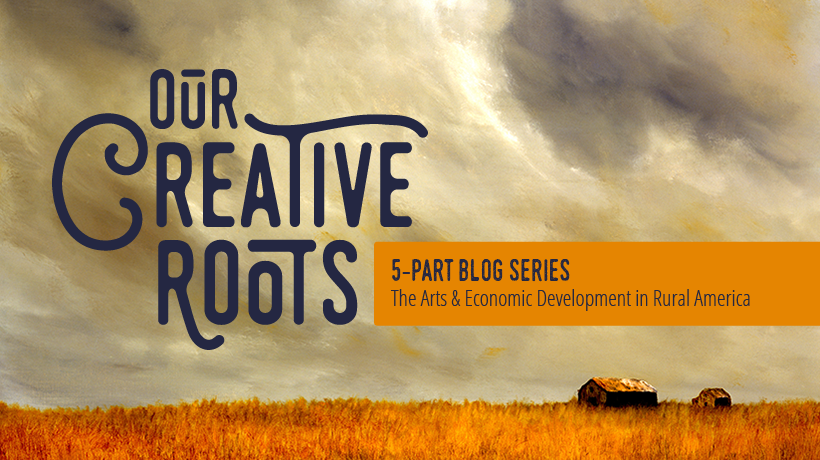In this 5-part series we will explore creative economy from the perspective of rural communities and challenges they face. In this post, author Patrick Overton kicks off our series by sharing his perspectives on the importance of developing methods for measuring the economic impact of creativity specific to the needs of rural areas. The following posts will look at how creative placemaking in rural areas is becoming increasingly essential to the sustainability of these communities long term. Our final post in the series will provide information, resources and a toolkit regarding approaches successful rural initiatives have taken.
Why rural areas and why now?
Rural areas across the US are experiencing population loss and the accompanying economic hardship. These communities are faced with the challenge of encouraging and inspiring the next generation to stay and give back economically and socially. Rural-to-urban migration is increasing based on a handful of factors including; technology exposing younger generations to urban lifestyles and inspiring a desire to migrate; trends in manufacturing causing industry and supply-chain shifts and relocation; and climate change related instability impacting agricultural production.
Thoughts on Measuring a Community’s Creative Vitality
by Patrick Overton, Ph.D.
I have two primary concerns about the way community creative vitality is assessed in our country. First, looking at economic statistics relating to arts jobs created and tickets sold to arts events doesn’t fully take into account the impact this has on the people who live in these communities. Measuring the impact of the creative economy appears to be based on an overarching assumption that arts salaries and ticket sales are the most relevant factors to be measured to determine a community’s creative vitality. It may be time to evaluate the validity of this assumption and expand the measurement to include the role of art in promoting individual and community capacity building by/for/of the community, especially the rural/small community.
Asking the Right People the Right Questions
Second, I am concerned that creative vitality can’t be measured the same way in rural and small communities as it is in larger communities and urban centers because there just aren’t the traditional arts resources available to do this. This results in limited information available to funders, significantly undervaluing the impact the arts have in the rural/small community setting. I believe the research answer we get is directly related to the research question we ask and I’m not sure we are asking the right people the right questions in the right place.
When resources are available, many of the projects are funded by outside resources utilizing artists from outside the community. If these projects are successful and sustainable, it can change the very essence of place identified with these rural/small communities. One way this happens is through gentrification that impacts every citizen in a community.
Measurement of Creativity Addressing the Needs of Rural Areas
We need to develop models of assessment that add to what quantitative data provide. We need to measure the impact in terms of human and social capital development and community creativity outcomes. These outcomes usually go undetected because we don’t ask questions about what really happens when people participate in and experience the arts on a personal basis. By doing this, we can measure the essential role the arts play in providing resources for individual, organizational, and community capacity building of/by/for the people who live in rural areas and small communities.
Rural Creative Placemaking Summit
This past October, 250 people attended the Next Generation/Rural Creative Placemaking Summit. This was organized by the Rural Policy Research Institute (RUPRI) at Iowa University in Iowa City and invited people to look at the role the arts play in creative placemaking, much of it in rural settings. Those of us attending shared stories and details of creative collaborations and partnerships among public, private, nonprofit, and community-based sectors to shape the character of rural, city, regional work around arts and cultural activities.
More rural/small community placemaking projects were highlighted at this event than any conference I have attended during my 40 year career. The interest in and success of this event confirms it is time for us to be more intentional about identifying the value of the arts in communities of every size in our country. Then and only then we will be able make a full and complete and compelling argument for the arts being essential to the lives of every citizen in our country, regardless of where they live.
About the Author
Patrick Overton is director of the Front Porch Institute, an organization created in 1997 to create organizational and community development resources. Overton has a Ph.D. in Communication, focusing expanding individual, organizational, and community capacity and has worked in community cultural development at the local, state, regional, and national level since 1976.
Overton is the author of Rebuilding the Front Porch of America: Essays on the Art of Community Making. Originally published in 1997, this book is being reissued as a Twentieth Anniversary Edition by Bitterroot Mountain Publishing Company. The book is scheduled for release in December 2016. Overton can be contacted at pmoverton@msn.com.
Interested in finding out more about the arts and economic development in rural America? Read Part 2 of 5: Our Creative Roots, Impact and the Homegrown Entrepreneur, featuring a look into White Sulphur Springs, Montana and Red Ants Pants.


Comments are closed.